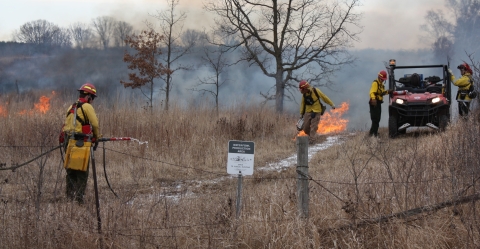What We Do
The National Wildlife Refuge System is a series of lands and waters owned and managed by the U.S. Fish and Wildlife Service. Wildlife conservation is at the heart of the refuge system. It drives everything we do from the purpose a refuge is established, to the recreational activities offered there, to the resource management tools we use. Selecting the right tools helps us ensure the survival of local plants and animals and helps fulfill the purpose of the refuge. Refuges use a wide range of land management tools based on the best science available. The management tools used are aimed at ensuring a balanced conservation approach where both wildlife and people will benefit.
St. Croix Wetland Management District works in partnership with many landowners, agencies and conservation organizations to restore and protect prairie, wetlands and oak savanna. This work includes habitat restoration and the promotion of programs to improve water quality.
Resource management tools used by the district include:
- Grazing to stimulate the growth of grasses and forbs, while setting back the growth of invading trees
- Controlling invasive species invasive species
An invasive species is any plant or animal that has spread or been introduced into a new area where they are, or could, cause harm to the environment, economy, or human, animal, or plant health. Their unwelcome presence can destroy ecosystems and cost millions of dollars.
Learn more about invasive species with chemical treatments and using prescribed burning and mowing on more than 1,000 acres per year to maintain grasslands
The district also works with private landowners to restore habitat through the Partners for Fish and Wildlife program. This voluntary program works with private landowners to cost share restoration of important wetland and grassland habitat in the district.
Management and Conservation
St. Croix Wetland Management District is working in partnership with the Wisconsin Department of Natural Resources to restore native grasslands on the landscape. Through a unique local ecotype seed nursery, the partners are growing five grass species and more than 25 forbs, or wildflower, species that are used to restore up to 400 acres of grasslands each year. Prairies provide food and cover for nesting waterfowl and other grassland nesting bird and animal species.
Trapping occurs on the district
Trapping is a wildlife management tool used on some national wildlife refuge national wildlife refuge
A national wildlife refuge is typically a contiguous area of land and water managed by the U.S. Fish and Wildlife Service for the conservation and, where appropriate, restoration of fish, wildlife and plant resources and their habitats for the benefit of present and future generations of Americans.
Learn more about national wildlife refuge system lands. Trapping may be used to protect endangered and threatened species or migratory birds or to control certain wildlife populations. The U.S. Fish and Wildlife Service also views trapping as a recreational and economic activity when there are harvestable surpluses of fur-bearing mammals. Signs are posted at district offices where trapping occurs. Contact the district manager for specific regulations.
Law Enforcement
U.S. Fish and Wildlife Service refuge law enforcement officers have a wide variety of duties and responsibilities. Officers help visitors understand and obey wildlife protection laws. They work closely with state and local government offices to enforce federal, state and refuge hunting and fishing regulations that protect migratory birds and other game species from illegal take. Other duties include maintaining refuge boundaries, participating in public events and maintaining relationships with neighboring landowners.
Law enforcement issues should be referred to the Project Leader Bridget Olson at 715-246-7784, ext. 112 or Law Enforcement Officer Scott Pariseau at 952-858-0711.
To report violations:
- Call or email the National Wildlife Refuge TIPs Line at 1-844-FWS-TIPS (397-8477) or fws_tips@fws.gov
- Call the State of Wisconsin’s TIP hotline at 1-800-847-9367
- Call Law Enforcement Officer Scott Pariseau at 952-858-0711
Please provide the following information: what happened, where it happened, who was involved (including descriptions/names of person involved, vehicle information, names of other witnesses) and when it happened.
Laws and Regulations
Special use permits are issued for compatible secondary uses such as research, firewood cutting and other related activities. Permits are also available for hunters with disabilities. Contact the district office for more information at 715-246-7784.

